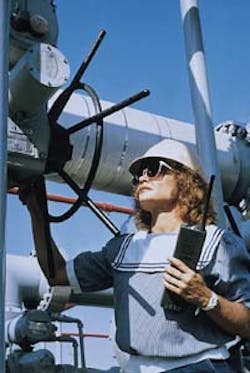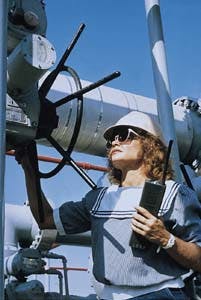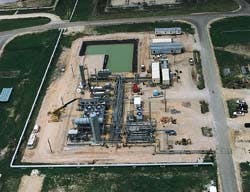SPR raids signaling demise of U.S. emergency oil stockpile?
Patrick Crow
Energy Policies Editor
Strategic Petroleum Reserve employee inspects valve at Big Hill, Tex., SPR storage site. Photo courtesy of U.S. Energy Department.
Now that the U.S. has begun to raid the Strategic Petroleum Reserve, its crude oil piggybank, there may be no stopping the process.
For budget reasons last year, Congress and the Clinton administration agreed to sell 28 million bbl of oil in three offerings, raising $545.8 million for the government.
The sales reduced the SPR stored volume by 5% to 564 million bbl and established a precedent that budget negotiators will find hard to ignore in the future.
Some congressmen think today's commodity markets have made the SPR obsolete. And they note it is expensive: A barrel of SPR oil represents a $35 investment, including the cost of building the SPR, buying the oil, and maintaining the facilities.
Kyle Simpson, DOE assistant secretary for energy programs, said, "I think the SPR sales issue will continue to be on the table when people look at other priorities" during budget negotiations. In fact, to balance its long-term budget proposal, the administration already has proposed to sell about 72 million bbl in fiscal 2002 to raise $1.5 billion.
At the suggestion of the Senate energy committee chairman, Sen. Frank Murkowski (R-Alas.), Energy Sec. Hazel O'Leary recently asked the National Petroleum Council, her oil industry advisory body, to conduct a top-to-bottom reevaluation of the SPR.
Meanwhile, prompted by a jump in New England heating oil prices last fall, DOE officials also will reexamine the need for regional product reserves.
In the past, New England and Hawaii (the latter is the most vulnerable state to a supply disruption, being 92% dependent on oil), have often asked for their own regional product reserves.
Both the SPR and regional reserve studies will be completed by early fall, just when Congress will be making critical decisions on the fiscal 1998 budget.
SPR study
John Shages, director of resource planning for the SPR, said, "the driver behind the SPR study is the question of the minimum level of oil storage needed."
He said the study also will look at drawdowns for budgetary reasons, use of the SPR to control gasoline or heating oil prices, whether the government should operate the SPR, and if it should exist at all.
DOE has often examined the idea of regional refined products reserves, most recently in 1991. Those studies concluded salt dome storage of crude oil was the cheapest and most flexible approach.
Shages said, "There are tremendous costs if you do anything on a regional basis. Product reserves can have operating costs of up to 10 times higher than crude because the inventory has to be turned over."
But he said DOE officials are aware conditions may have changed since the last review, and "a fresh look" is warranted.
Insurance policy
The SPR, consisting of four storage caverns on the U.S. Gulf Coast, is the world's largest emergency oil stockpile (Table 1 [10840 bytes]).
Since 1976, the U.S. has spent more than $20 billion to buy 592 million bbl of crude and store it so it could be delivered quickly into the U.S. market.
The caverns have 680 million bbl of capacity, and at one time Congress had planned to expand the SPR to 1 billion bbl.
DOE officials concede Congress is likely to continue selling SPR oil to fund future SPR program budgets but suggest there is a limit to the sales.
They note the Energy Policy and Conservation Act gives the President the authority to sell as much as 30 million bbl absent a crisis-if 500 million bbl remains after that sale-thus establishing a minimum legal SPR inventory of 530 million bbl.
Under its obligations to the International Energy Agency, the U.S. must maintain 90 days of oil stocks, private or government. But the U.S. can meet that obligation with private stocks alone.
Currently, the SPR could be drawn down at a maximum rate of 3.5 million b/d, less than half of U.S. import dependence. That rate will rise to 3.9 million b/d next year, when a degasification project is completed.
DOE officials had advised the administration against the latest SPR sales but were overruled.
Asked how big the SPR should be, Kyle Simpson, associate deputy energy secretary, replied, "You tell me how big the next energy crisis will be. The general feeling at DOE is the bigger it is, the better it is, because it is an insurance policy."
Weeks Island
Ironically, DOE was responsible for the first leak in the dike holding SPR oil.
The department discovered that the first and smallest SPR site, Weeks Island near New Iberia, La., needed to be closed because a sinkhole had developed in the salt formation above the oil storage chambers, allowing an intrusion of surface water that threatened to flush some of the crude out of the caverns into the marshes of Louisiana.
Since it would have to transfer the 72 million bbl of Weeks Island oil to other sites anyway, DOE suggested selling some of it to cover the $100 million cost of closing the site. Congress agreed.
The Defense Department's Defense Fuel Supply Center (DFSC), which handled the purchase of oil for the SPR, conducted the sale of 5.095 million bbl of 29.1° gravity sour crude for an average price of $18.92/bbl. The $96.4 million sale was completed in late March after four bid cycles (OGJ, Apr. 1, 1996, p. 36).
DOE said, "Weeks Island is unique among the SPR storage sites, having once been a commercial salt mine. The other sites are much deeper caverns created by dissolving huge cavities in the salt domes along the Louisiana and Texas Gulf Coast. The deeper salt caverns are much less susceptible to the type of naturally occurring fracturing that has been experienced at Weeks Island."
In late 1995, DOE built an underground freeze wall around the sinkhole to control ground water inflow while the Weeks Island oil was shifted elsewhere.
DOE transferred most of the Weeks Island oil to the Bayou Choctaw site, 12 miles southwest of Baton Rouge, or to the Big Hill site, 20 miles southwest of Beaumont, Tex. The emptied caverns were filled with brine to minimize surface subsidence.
The other two SPR sites are Bryan Mound, near Freeport, Tex., and West Hackberry, 22 miles southwest of Lake Charles, La.
Subsequent sales
With the Weeks Island sale as an example, congressional conferees working on the fiscal 1996 budget required DOE to sell another $227 million worth of Weeks Island oil to fund education programs.
When gasoline prices jumped in May, President Bill Clinton ordered that sale expedited to help quell markets (OGJ, May 6, 1996, p. 44).
Clinton's action prompted the American Petroleum Institute to observe, "The SPR never was intended to be used to control prices or to dampen normal price fluctuations. The SPR was designed as a strategic stockpile to provide Americans with a buffer in case of a major oil supply disruption or shortage."
It noted the 12 million bbl sale only amounted to about 1.5 days of U.S. oil imports and a sixth of the world's daily oil consumption of 70 million bbl.
The second Weeks Island sale disposed of 12.82 million bbl for $227.8 million, an average weighted sales price of $17.77/bbl. World oil prices dropped during the nine bid cycles last summer. The first sale was for $19.56/bbl and the last for $17.87/bbl.
Then, in the fiscal 1997 budget, Congress required DOE to sell $220 million worth of West Hackberry sour crude to pay for SPR operations during the period.
In six offerings during the fourth quarter, DFSC sold 10.2 million bbl for $220.6 million, or a weighted average of $21.62/bbl (Table 2 [98227 bytes]).
Surplus facilities
Last fall, DOE signed agreements with two pipeline companies to sell or lease Strategic Petroleum Reserve oil pipelines and a government-owned marine terminal (OGJ, Nov. 4, 1996, p. 38).
Louisiana Intrastate Gas Co. of Alexandria, La., bought a 67-mile, 36-in. pipeline between Weeks Island and the St. James marine terminal on the Mississippi River.
Because DOE was decommissioning Weeks Island, it no longer needed the pipeline. The $22 million sale will close when DOE finishes the oil transfer.
Shell Pipe Line Corp., Houston, leased DOE's St. James terminal and a 37-mile, 36-in. pipeline connecting it with the Bayou Choctaw SPR site in Louisiana. The terminal has six storage tanks, two docks, and connections to the Capline and Locap commercial pipelines.
The lease will earn DOE as much as $8 million/year while saving it the same amount in operating and maintenance costs. DOE retained the right to use the terminal and pipeline to draw down SPR crude during an emergency.
DOE has little hope of selling the Weeks Island site, which consists of only 4 acres on the surface but has been talking about options with Louisiana officials and owners of the adjacent Morton Salt facility.
Richard Furiga, deputy assistant secretary in charge of the SPR program, said DOE also is talking with several countries interested in leasing part of the more than 100 million bbl of spare SPR capacity.
Congress has authorized such leasing. It would not be unusual, for there is some crossborder storage in Europe now.
DOE said it would cost foreign nations less than $2/bbl/year to store oil in its caverns, while those nations would face construction costs of $15-$50/bbl to build surface tankage or mine caverns, plus annual operating costs.
And although physically located in the U.S., the foreign-owned oil could be swapped during an energy shortage.
Furiga said, "Although we don't have any deals imminent, something could develop." South Korea is believed to be one of the countries interested.
Degasification plant is processing crude stored at Bryan Mound, Tex., Strategic Petroleum Reserve site. Intrusion of methane from surrounding salt formations at this and other SPR sites had raised concentrations of natural gas in the crude to levels that could be dangerous if drawn down. Photo courtesy of U.S. Energy Department.
Maintenance push
DOE has launched a life extension program for the aging SPR to keep it functional through at least 2025.
The SPR was designed for a 20-year life when it was built in the 1970s, and many pumps, valves, and piping need to be replaced. Also, some systems need to be streamlined.
The rejuvenation program also has another long term cost savings goal: standardizing all new and replacement equipment in order to simplify warehousing, maintenance, and operations.
Officials explained that the SPR was built during a boom in the oil industry and equipment was hard to get and impossible to standardize.
The life extension program is costing $351 million during 7 years.
Furiga said, "We also are getting rid of components we no longer need, like valves and pumps used to leach caverns, since we no longer are building new capacity."
Two other problems have arisen with about 200 million bbl of the stored oil.
DOE discovered in 1993 that intrusion of methane from surrounding salt formations had raised concentrations of natural gas in the crude to levels that could be dangerous if drawn down.
A degasification unit already has processed the crude at West Hackberry and Bayou Choctaw and will go to Big Hill next. Another unit is working at Bryan Mound, which has most of the gassy oil. The program is due completion in April 1998.
Also in 1993, DOE said geothermal heating had increased the temperature of some of the stored oil, raising its vapor pressure. That problem was solved by installing surface heat exchangers for use during drawdowns.
Industry concerns
The oil industry has raised the loudest objections to the depletion of the SPR.
The Independent Petroleum Association of America told President Clinton in a letter last October that SPR oil should not be used to fund government programs or interfere with oil market fluctuations.
It also was concerned about how the sales would affect oil prices: "U.S. producers already compete with a record high level of imports. We shouldn't have to compete against our own government dumping oil on the market."
John Lichtblau, Petroleum Industry Research Foundation chairman, said there is a strong advantage in government-owned and controlled oil stocks: They can mitigate the impact of a supply disruption by increasing the physical supply of oil and provide more time to seek diplomatic solutions to international conflicts.
He said, "The use of the SPR at the outset of Operation Desert Storm in January 1991 provided an instantaneous counterforce to the expected market panic, even though the volumes finally sold were small."
Lichtblau said, "Some analysts have theorized that the SPR could be replaced by the diligent use of the now-mature futures market. The futures markets, vital as they are to the current oil market, would be no substitute for the SPR, because physical volumes are the only salve to an overheated market during a supply crisis.
"Futures transactions provide no incremental supply to the system. Thus, while futures transactions can effectively reduce a corporation's or a consumer's exposure to price fluctuations, they do not dampen the price move.
"Furthermore, prudence dictated that the New York Mercantile Exchange take measures during the Persian Gulf crisis to suspend trading in the most frenzied periods, providing an orderly cool-down for futures. There is no similar hiatus in the need for physical barrels, however."
He said rising oil imports are eroding the SPR insurance policy. In 1986, SPR stocks equaled 95 days of imports, at the end of 1995 they were 75 days, and they are projected to be less than 60 days in 2000.
American Petroleum Institute said that as oil imports continue to increase, so should the size of the SPR stocks: "The SPR is not just useful in a disruption. By its very existence, it acts as a deterrent to a politically inspired supply cutoff."
But Jan Paul Acton, a Congressional Budget Office analyst, told a House committee hearing last year that the optimal size of the SPR is smaller than it used to be.
"The efficiency of oil markets has improved, partly because of greater diversity of supply. The economy is now less dependent and more flexible in the use of oil than it has been in the past. And world economies are becoming more interdependent.
"All of those changes reduce the benefits of having a reserve of any given size by lowering the threat of a disruption or the economic costs of a disruption should it occur."
Off-budget solution
Former Sen. Bennett Johnston (D-La.), a key architect of current U.S. energy policy the past 2 decades, said selling any SPR oil in a nonemergency is "a great mistake."
Copyright 1997 Oil & Gas Journal. All Rights Reserved.


